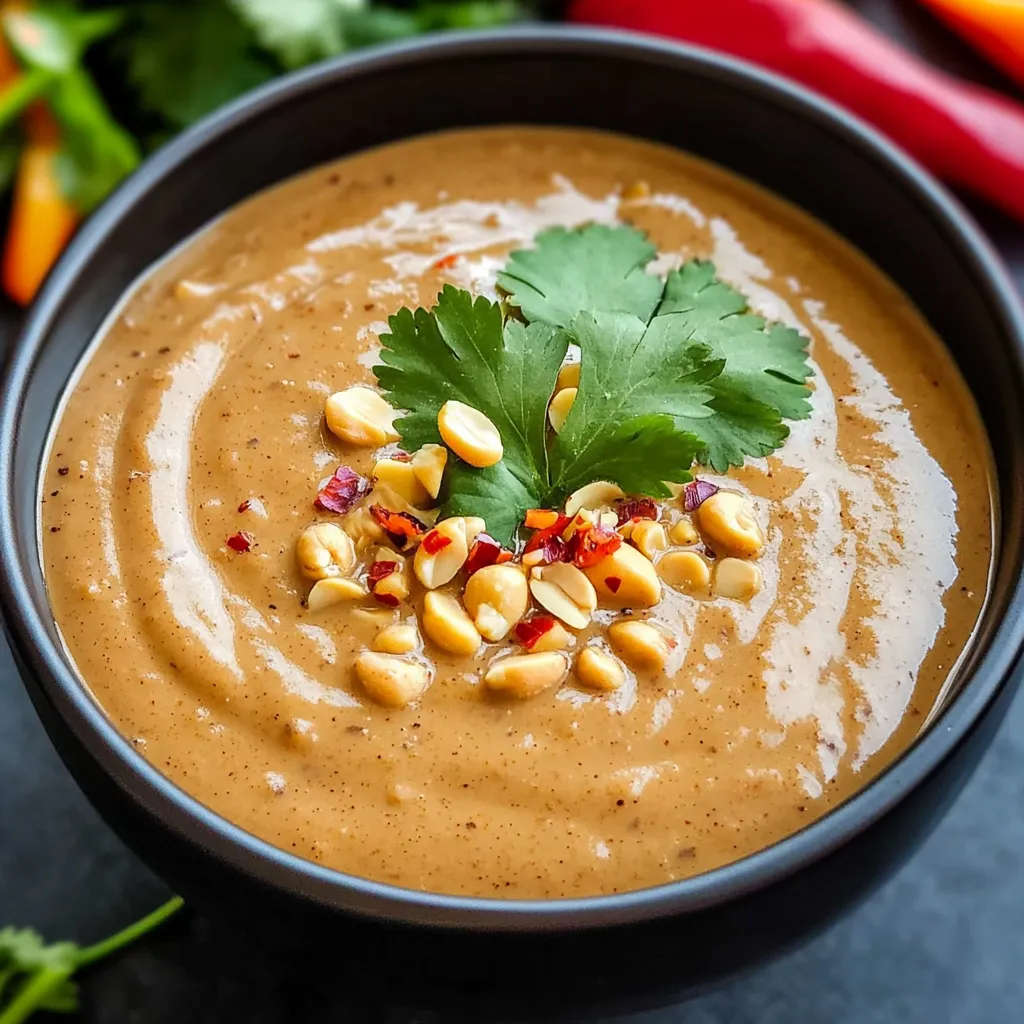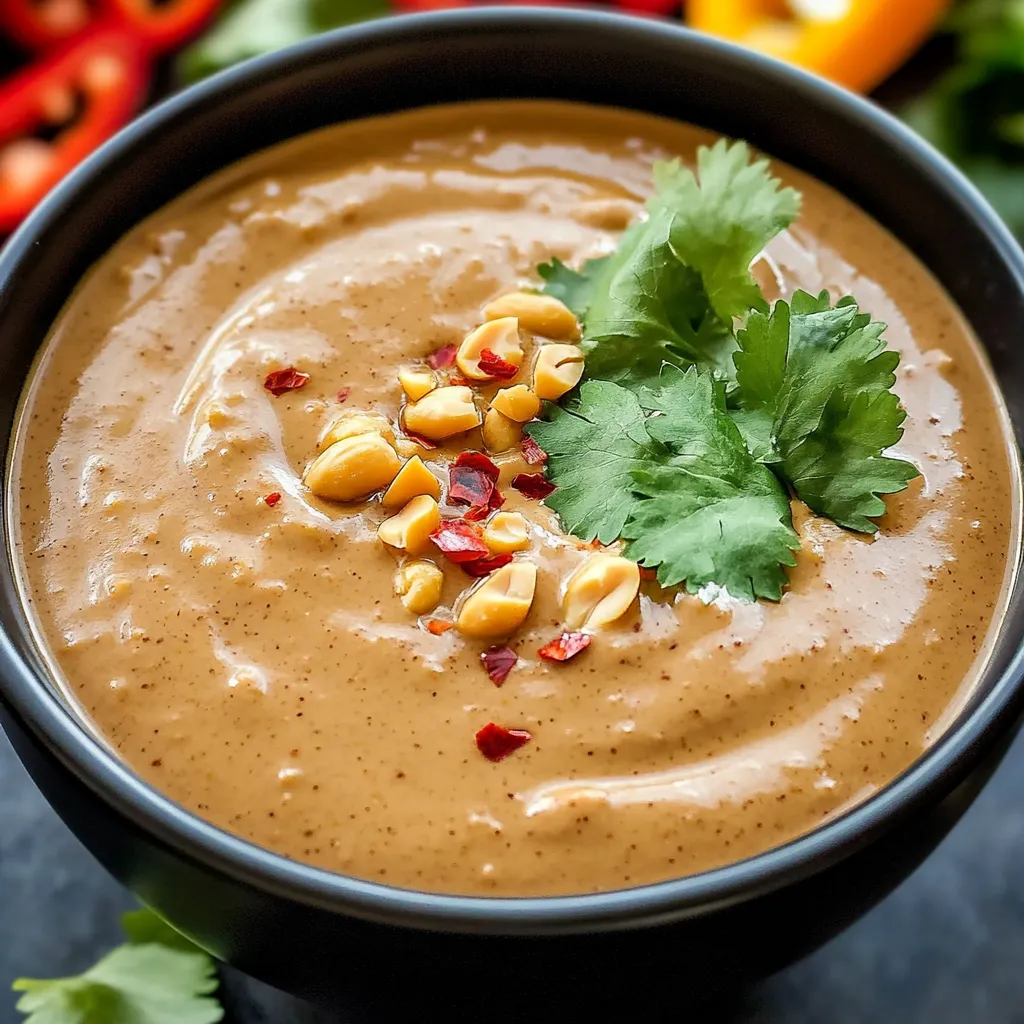 Pin it
Pin it
When this smooth sauce hits your taste buds, you'll get a burst of sweet, rich, zesty, and hot flavors all at once. I've spent ages trying to copy what my go-to restaurant makes, and this recipe has become my kitchen hero – it turns basic veggies and plain noodles into something amazing. What's great isn't just how the flavors come together perfectly, but how you can use it for so many things – dipping, soaking meat, or topping salads. I always have some in my fridge, ready to save even the most boring meal with its smooth, rich flavor combo.
The other day, I poured this sauce on some roasted veggies that were about to go bad in my fridge. My picky teen who usually runs from anything green asked for more and then used bread to clean up every bit of sauce left on his plate!
Key Ingredients
- Creamy Peanut Butter: The base that gives thickness and richness
- Soy Sauce: Brings that savory depth and salt kick
- Fresh Lime Juice: Adds zing that cuts through the richness
- Sweetener: Honey or maple syrup smooths out all the flavors
- Sesame Oil: Gives that nutty taste that makes the sauce special
- Warm Water: Helps you get just the right thickness
Making Your Sauce
- Mix Flavors Right:
- Put peanut butter in as your creamy start. Drop in soy sauce for that salty kick. Squeeze lime for that tangy touch. Pour in some sweet stuff to smooth things out. Add hot stuff to match what you like.
- Get The Right Thickness:
- Start by mixing the main stuff into a thick blend. Pour warm water bit by bit, one spoon at a time. Keep stirring until it's totally smooth. Make it thicker or thinner based on how you'll use it. Let it sit a little so flavors can mix well.
- Make It Your Own:
- Taste as you go, not just when you're done. Add more sweet, sour, or spicy as needed. Try throwing in fresh ginger or garlic if you want. Don't let any one flavor take over. Keep in mind it gets stronger after sitting awhile.
- Serve It Best:
- Keep it thick for dipping stuff. Add more water for drizzling on salads. Let it warm up before using. Give it a good stir if it's been in the fridge. Top with crushed peanuts or fresh herbs when it makes sense.
 Pin it
Pin it
Keeping It Fresh
This sauce stores really well, so it's great for planning meals ahead or adding quick flavor boosts. After you make it, put it in a glass jar or sealed container and stick it in the fridge for up to a week. Don't worry when it gets thicker in the cold – that's totally normal. When you want to use it, just let it sit out for about 15-20 minutes to warm up, and maybe add a splash of warm water if it's too thick. Give it a good shake or stir to mix everything back together. I wouldn't try freezing it since the texture might get weird, but it's so quick to whip up that making a fresh batch isn't much trouble anyway.
Foods That Go Great
This sauce works with so many things, making it super handy in the kitchen. For starters, use it to dip fresh spring rolls, meat skewers, or raw veggie slices. For main meals, drizzle it over bowls of rice with roasted veggies, mix it with cold noodles for a quick lunch, or soak tofu, chicken, or shrimp in it before grilling. It makes a tasty salad topping when you thin it out with a bit more water or lime juice, especially on hearty grain salads loaded with crunchy veggies. For a simple snack, spread it on rice cakes or dip apple slices in it for a weirdly good sweet-and-savory combo that you won't be able to stop eating.
Fixing Common Problems
Even this simple sauce can sometimes give you trouble. If you see it separating or looking oily, your peanut butter was probably too cold - next time, let everything warm up first, or heat the peanut butter for a few seconds. If your sauce is runny, just add more peanut butter bit by bit until it's how you want it. If it's too thick, slowly stir in more warm water. When it tastes too salty, balance it out with more sweet stuff and lime juice. For a gritty texture, you might need to try a different brand of peanut butter or blend everything in a food processor. Just remember that the flavors get stronger over time, so something that tastes perfect when you make it might seem too strong after sitting in the fridge.
 Pin it
Pin it
Final Thoughts
This Thai Peanut Sauce shows how easy cooking can be while still tasting amazing. It proves that a few simple ingredients mixed right can create something way better than you'd expect, bringing exciting flavors to everyday meals without much work. Whether you want to make plain veggies taste better, throw together a quick lunch, or add something special to dinner, this sauce brings big flavor that feels fancy but isn't hard to make. As you find more ways to use it in your cooking, this recipe will probably become one you make again and again – which is exactly what makes a truly great sauce stand out from the rest.
Frequently Asked Questions
- → Can I swap natural peanut butter for creamy peanut butter?
- Yes, but natural peanut butter has a slightly different texture and taste. It might be oilier or thinner, so you might need to tweak how much warm water you add to get the consistency you want. Also, mix the separated oil well before measuring!
- → What's a gluten-free replacement for soy sauce?
- You can use tamari or coconut aminos as gluten-free swaps for soy sauce. They both bring a similar savory taste and are perfect for anyone avoiding gluten!
- → How do I store leftovers?
- Pop any leftovers in an airtight container and keep them in the fridge for up to a week. If it thickens or separates, just stir or whisk it well before using again.
- → Can I add other flavors to this sauce?
- Definitely! Boost it with grated ginger, fresh cilantro, chopped green onions, or even a splash of coconut milk for extra creaminess. Adjust liquids if you add more solid ingredients.
- → What can I use to make this nut-free?
- Swap peanut butter for sunflower seed butter. It offers the same creamy texture but works great for those with peanut allergies.
- → How do I make this vegan-friendly?
- It’s easy! Switch out honey for maple syrup or another plant-based sweetener. Everything else in the mix is already perfect for vegans!
